This is a story about money. Lots and lots of money. Money that most people in Armenia have never seen but which has affected every last Armenian life. This is a story of millions upon millions of dollars, thousands of foreign-funded activists and the hundreds of organizations that usurped power in Armenia and led the country to the edge of the abyss.
At the end of the Soviet Union, Francis Fukuyama claimed that with the fall of Soviet communism, liberal democracy had won, calling it “the end of history.” Fukuyama and others believed that liberal democracy was the last remaining option believing that liberal democracy would naturally take over the world. It did not take long for people, including Fukuyama himself, to realize that this was a pipe dream and that liberal democracy could not be considered an eventuality. Thus was born the goal of imposing liberal democracy on the newly independent states of the former Soviet Union and the Eastern Bloc.
But there was one distinction. During the Cold War, the West, led by the United States, had actively armed local subversives and even executed coup d’etats through the coordination of the Central Intelligence Agency (CIA). However, with the revelations of the Pentagon Papers, the Iran-Contra affair, and other subversive covert activities around the world, public opinion of the US government was severely damaged. So, a shift occurred, where guns and cover operations were replaced with mass communications technology and the open financing of local groups.
Nobody stopped to ask one very important question: what business does any foreign government or any international organization or any private foundation have participating in the domestic affairs of a sovereign country? The short answer is that they do not.
The Empire of Democracy
International politics is ultimately about power. One must understand this in order to understand the motivation behind countries involving themselves in the affairs of other countries. While guns and spies took a backseat to computers and activists, the goal remained the same: power. There have been many euphemisms to describe this new mode of operations but the two most common are soft power and public diplomacy. Media outlets, civil society organizations, movies, and directed investments are vehicles through which soft power is exercised.
Among the largest elements of these public diplomacy efforts to shift countries in the direction of liberal democracy is a multibillion dollar international grant industry that funds thousands of NGOs throughout the world. While it is cloaked in deceptively innocuous phraseology, the liberal democratic grant industry led by the United States, the European Union, and certain private foundations is effectively a modern rendition of imperialism.
The catchphrases “democracy,” “human rights,” and “corruption” are the updated reflections of haughty imperial contempt previously represented by the white man’s burden and the mission civilisatrice; the private foundations are the British East India Company and the Dutch East India Company, trafficking in their wares abroad, setting up outposts, and depending on the support of their home governments – and now international institutions like the United Nations. Locals are recruited to perform certain tasks, like the sepoy in India, but, instead of guns, they are given computers to carry out their missions. And, in 2018, Armenia was converted into a full-fledged vassal, much like the princely states of the British Raj, one with a local leader but subject to the British Empire.
This situation is what makes the supposedly countercultural recipients of the funds all the more ironic and risible: those who receive money from foreign governments are the local agents of neo-imperial powers who are determined to promote their political agendas abroad.
The elephant in the room that undergirds the problem of foreign funding is whether the funding is provided to address issues of local interest or if foreign interests determine the direction of the local actors. In case the adage that “money isn’t free” is insufficient to prove that it is the foreign organizations and governments providing the funding that determine the course, we can look at calls for grant proposals.
Let us consider how the United States or the European Union would react if a theoretically super-wealthy Armenia decided that it wanted to influence American and European society by funding media and civil society organizations there that promoted the values of the Armenian Apostolic Church, Nzhdeh’s Tseghakronism, and traditional family values. Would this be acceptable in places that have values opposed to those Armenian national values? Certainly not. So why is it acceptable to allow unhindered access to foreign patrons and their local proxies to promote political agendas and values that are largely incongruous with the interests of the Armenian state and its society?
If you are having trouble viewing the map above or would like to explore it in greater depth, you can follow the link here.
The Patrons
Any research into the funding sources of NGOs in Armenia and elsewhere in the developing world will reveal that there are hundreds of funding organizations, large and small. The benefactors can be split into three broad categories: international and supranational organizations and governments, national governments, and private foundations.
The United Nations and its subsidiary organizations – UNDP – UN Development Program, UNICEF – UN Children’s Fund, UNFPA – UN Population Fund, and others – and the European Union and its affiliates like the European Endowment for Democracy are examples of international and supranational organizations, respectively. National governments like the United States and its administrative offices like the US Department of State and the US Agency for International Development (USAID), and its affiliates, the National Endowment for Democracy and the National Democratic Institute and, in Armenia’s case, the governments of the United Kingdom.
Indeed, the role that NGOs were to play in this replacement of the imposition of political will through physical force was foreshadowed by United States Secretary of State Colin Powell when, in remarks to the National Foreign Policy Conference for Leaders of Nongovernmental Organizations in 2001, he said, “And I want you to know that I have made it clear to my staff here and to all of our ambassadors around the world that I am serious about making sure we have the best relationship with the NGOs who are such a force multiplier for us, such an important part of our combat team.”
NGOs are a combat team in what war, exactly?
The Democracy Promotion Network
John Fonte, a fellow at the Hudson Institute, has coined the term “Democracy Promotion Network” to describe the international organizations, governments, and private foundations that work in conjunction with each other to promote a transnational progressive, or globalist, vision of the world in a way that, paradoxically, undermines democracy and threatens the sovereignty of independent nation-states. In an essay titled “Sovereignty and Its Enemies,” Fonte writes:
“Transnational progressives, or globalists, represent a major challenge to democratic nation-states because they seek to transfer political decision-making from democratic nations to supranational authorities and institutions. The decades-long trajectory of the European Union is an example of this phenomenon.
These globalists include the leadership of the United Nations and the European Union; bureaucrats from the World Trade Organization and the International Monetary Fund; judges from the European Court of Human Rights and the International Criminal Court; career officials in the U.S. State Department, the British Foreign Office, and the German Foreign Ministry; American CEOs of major global corporations; employees of NGOs such as Amnesty International, Human Rights Watch, and Greenpeace; and prominent American international relations specialists and international lawyers, including the leadership of the American Bar Association.
But another anti-sovereignty force is simultaneously at work: the American democracy promotion network. What role, if any, do the promoters of democracy play in the worldwide ideological conflict between democratic sovereigntists and globalists?
The American democracy promotion network is based in organizations such as the National Endowment for Democracy (NED) and Freedom House and includes an array of prominent writers.”
The National Endowment for Democracy, one of the largest foreign grantees in Armenia, makes no secret about its intention of using its funding to influence the political actors in foreign countries. Indeed, its leaders have admitted that the NED effectively continued the work of “democracy promotion” that was previously done covertly by the Central Intelligence Agency (CIA). Carl Gershman, who has been president of the NED since 1984 – an incredibly long time for one man at the helm of an organization promoting democracy – was quoted in a 1986 New York Times article as having stated that, ”It would be terrible for democratic groups around the world to be seen as subsidized by the C.I.A.” (Missionaries for Democracy: US Aid for Global Pluralism, New York Times). Gershman’s sentiments were echoed by Allen Weinstein, acting president of the NED in 1991 when, in an interview in the Washington Post with David Ignatius, said, “A lot of what we do today was done covertly 25 years ago by the CIA.”
While the NED claims that it does not work with the CIA, there is no secret about its intentions in affecting the political landscape of foreign countries, including Armenia. Putting aside the egregious but oft-ignored revelation that a foreign government-backed organization is actively funding politically-motivated groups across the world, it is important to note that the NED is less a tool for positive political change in sovereign countries than it is a way to pressure governments and exert influence on them.
One of the problems with the National Endowment for Democracy is that it is not terribly concerned with democracy or the principles it purportedly supports. One of the most succinct criticisms of the NED’s activities was offered by former Texas congressman Ron Paul in rejecting a proposal to increase the NED’s funding in Congress in 2005.
“This bill continues to fund organizations such as the National Endowment for Democracy, which as I have written before has very little to do with democracy. It is an organization that uses U.S. tax money to actually subvert democracy, by showering funding on favored political parties or movements overseas. It underwrites color-coded “people’s revolutions” overseas that look more like pages out of Lenin’s writings on stealing power than genuine indigenous democratic movements. The NED used American taxpayer dollars to attempt to guarantee that certain candidates overseas are winners and others are losers in the electoral processes overseas. What kind of message do we think this sends to foreign states? The National Endowment for Democracy should receive no funding at all, but this bill continues to funnel tens of millions of dollars to that unaccountable organization.“
Sound familiar?
The “Soros Conspiracy” Canard
A favorite retort by those who receive their funding from foreign sources is to refer to those drawing attention to the copious amounts of money flooding into developing countries as “the Soros conspiracy.” This is in reference to the understandably repetitive referencing of George Soros and his Open Society Foundations which play an outsized role in funding the activities of local NGOs.
What is curious about this accusation of conspiracy theorizing is that Soros and his Open Society Foundations make absolutely no secret about their association with the billionaire who named his notorious money granting organization in honor of the idea proposed by the political philosopher Karl Popper. In fact, all the criticisms of Soros and OSF notwithstanding, they are relatively forthcoming about their activities in Armenia, offering a comprehensive – though difficult to search – list of all the grants they have provided, during which years, the amounts, and the purposes, on their website.


The fact is that pretending that the millions of dollars that Soros, through the Open Society Foundations, has injected into Armenia to reshape the political environment and society itself is nothing but a canard meant to distract from the very real problem of a billionaire setting a vision for the world he wants to see.
Otherwise, the implication is that it is acceptable to flood a poor and developing country like Armenia with a billionaire’s money to realize his own personal vision, with little to no regard for the needs and norms of the country and its people. Besides approaching the heights of conceit, how is this anything but an infringement upon the sovereignty of Armenia to set its own course?
Lies, Myths, and More Lies
One might ask why there is so much foreign money in Armenia specifically targeting the media. An anachronistic myth persists that the Armenian media landscape is overwhelmingly controlled by government “oligarchs,” a favorite term of liberals across the post-Soviet world which is simply an epithet for local businessmen that they dislike. Based on this mythical premise, activists and NGOs rationalize applying to and receiving foreign funds.
First, it is extremely unlikely that Armenia’s local economy could support so many media outlets, even if the assets of local business owners were evenly distributed in media across the political spectrum.
The greater problem, however, is that the foreign-funded media outlets engage in highly politicized reporting that can be frequently described as dishonest, selective, omissive, and based on half-truths. One example is Hetq, which, August 2018, printed a call to action supposedly meant to uncover the assets of Robert Kocharyan and his family.


Hetq did no actual reporting for the piece. It just reprinted a list compiled by a shady Russian website, versia.ru. With absolutely no evidence, Hetq reprinted the list that suggested the Kocharyan family owned Zvartnots Airport, the national postal carrier Hay Post, no less than four banks, at least two mines, and dozens of other properties. Not a single piece of evidence, not a single citation.
There was never any follow-up. That was it. This recipient of hundreds of thousands of dollars from foreign governments and organizations was actively engaged in the defamation of a former president of Armenia and national hero without any substantiation. This piece of cheap yellow journalism has been repeatedly used as “proof” by fleeceable readers to continue damaging Kocharyan’s reputation despite the lack of any evidence of wrongdoing.
This unethical behavior not only did not have a pejorative effect on the funding Hetq received, it was correlated with a marked increase in the funding it received in 2019: $378,916, a 690% increase in the funding it received from the year before from the National Endowment for Democracy and the Soros’ Open Society Foundations.
Hetq is not the only outlet that engaged in this questionable behavior. For example, MediaLab, which received over $146,000 from NED between 2017 and 2019, and over $157,000 from OSF during the same period, was actively involved in propagating the myth that Armenian soldiers were ill-equipped, even going so far as repeating the pedestrian lie in a political cartoon that frontline soldiers were fighting the enemy with shovels.

The Proxies
According to a 2019 report by USAID, there are over 4,794 public organizations (also known as non-governmental organizations, or NGOs) and 1,212 foundations in Armenia. This makes over 6,000 civil society organizations (CSOs) which, assuming a population of 3 million people, means there is one CSO for every 500 people.
For the past thirty years, Armenia has been a developing country but it has registered considerable growth, achieving upper middle income status according to the World Bank. However, there remain many societal, economic, and political issues in the country, including unemployment among young men, the presence of serious health issues like cardiovascular disease and cancer, problems with the quality of education, a wide structural skills gap since the collapse of the Soviet Union and, of course, the ongoing war with Azerbaijan. Despite these pressing problems which have wrought havoc on Armenian society including by creating massive flows of temporary migrants to Russia that disrupted and decimated whole communities in Armenia, causing irreparable damage to thousands of families, these local NGOs, due to funding that they received from foreign actors, developed programs that seem as if they were dreamt up in an alternate universe.
While Armenian villagers were being shot upon by Azerbaijani snipers and drunk soldiers, foreign-funded NGOs like Media Initiatives Center were producing documentaries on the brief history of peaceful coexistence between Armenians and Azeris – on more than one occasion. While Turkey’s president Recep Tayyip Erdogan was saying that Turkey “backs Azerbaijan ‘to the end'” when the latter launched a war against Armenia in April of 2016, foreign-funded organizations like Civilitas/CivilNet, the Public Journalism Club, the Helsinki Citizens’ Assembly, and the Regional Studies Center were receiving money to participate in Turkish-Armenian reconciliation programs. When the Armenian government was trying to reform the military and concurrently create a fund to help the families of injured and killed Armenian soldiers, foreign-funded organizations like Armenian Progressive Youth were producing reports titled Radicalization and Culture of Violence Among Youth in Armenia, somehow tying the $2 tax to “further radicalization” and supposed “military rhetoric” that purportedly threatened “LGBT people, feminists and peacemakers” in Armenia.
Obfuscated “Open” Information
The organizations and their mission statements are dressed up with an innocuous and laudable vocabulary that seems to have been taken from a common grab bag used by all aspiring NGOs: “rights,” “transparency,” “equality,” “civil society,” “democracy,” “progress,” “civic engagement,” “accountability.” This is a preventative measure developed by activist organizations. After all, it is easier to criticize an organization named “Abolish the Military” in a country at war than it is any number of organizations and individual activists that work on weakening the military under the guise of “transparency” or “democratic values.” It also obfuscates what the organization actually works on. Indeed, obfuscation through tangled networks, opaque sources of funding, and euphemistic descriptions of their work have gone a long way in making it extremely difficult to keep track of the organizations and their activities. It is important to keep in mind that the funding sources described here and in the graphical representation are just the sources of funding and support that are publicly available.
For example, many organizations make it difficult to know where exactly they get their financing. One common tactic that is employed is simply not listing the sources of funding. Another is to refer to funding organizations under the general term “partners,” which does not necessarily denote a financial partner. At that point, the only hope of knowing whether there was an exchange of funds is to inquire with the partner organization to see whether they have reported providing funds to the Armenian NGO.
Often, the funding for the organization is done indirectly, so as to obfuscate the source. For example, the Women’s Resource Center receives funding from Kvinna till Kvinna, a Swedish funding organization, which in turn gets its funding primarily, but not solely, from Sida, the Swedish aid agency, which is in turn funded by the Swedish government.
However, Women’s Resource Center Armenia is also one of the sister organizations of Human Rights House Yerevan, itself a subsidiary of Human Rights House Foundation, based out of Norway, and which receives funding from the Norwegian, Czech, and Swiss foreign ministries, as well as from the European Union.
As to what amounts are provided to either the Women’s Resource Center Armenia or any other Armenian organization through this complex web of governments, foundations, subsidiaries, and re-granting organizations is anyone’s guess.
Another example of this is the media-related NGO Media Initiatives Center. Established in 1995 as part of a US-based network called Internews, Media Initiatives Center partners with a long list of foreign governments like the United States, British, European, Swedish, and other governments, and private foundations like the Open Society Foundations, the Konrad Adenauer Foundation, Eurasia Partnership Foundation, and other institutions like the US-based and government-funded National Endowment for Democracy, as well as the European Endowment for Democracy.
Sometimes the original funding organization itself makes it impossible to know how much money was provided to the recipient. For example, the European Endowment for Democracy, which describes its missions as providing “flexible support to democracy activists, complementing other EU and EU member state democracy support programmes. EED is demand-driven and responds to the needs of local democracy actors, who may not be able to obtain funding otherwise.” However, one of its grant recipients in Armenia, the Union of Informed Citizens NGO, founded and operated by Daniel Ioannisyan, has no trouble finding grants elsewhere: is also one the top grant recipients of the Armenia branch of Open Society Foundations, received over $1,000,000 in funding only from the NED and OSF between 2016 and 2020. Nevertheless, the European Endowment for Democracy does not list the grant amounts so it is not possible to know how much was provided to Ioannisyan’s group.
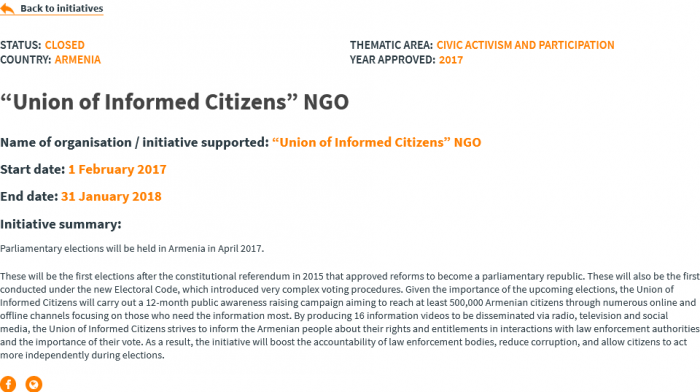
In 2016, Media Initiatives Center reported on its balance sheet assets of over $2 million, 88% of which were listed as “Other Accounts Receivable.” However, there was no information available about where they expected to receive those funds. That aside, Media Initiatives Center is an organization that offers support to others in the country.
One such case of support provided by the Media Initiatives Center is CivilNet, one of the most well-known media platforms in Armenia and the Diaspora. If you were looking to find what funding CivilNet receives, you would be disappointed because CivilNet itself does not receive funding – not directly, at least. That is because CivilNet is a project of Civilitas Foundation, founded by former foreign minister Vartan Oskanian and his special assistant, Salpi Ghazarian, the same team behind Armenia International Magazine (AIM) in the early 1990s.
CivilNet is a project of the Civilitas Foundation which itself receives support from a long list of sources including the governments of the UK, Norway, the European Union, Germany, the Netherlands, Poland, Switzerland, the US Embassy in Yerevan, USAID, Media Initiatives Center, Internews, Eurasia Partnership Foundation, and the UN Development Program.
With Ghazarian at the helm, CivilNet was one of the foreign-funded outlets that spent the ten years of the Serzh Sargsyan administration creating an environment of disgust and rage in Armenian society, precipitating the April 2018 rebellion by Nikol Pashinyan. It is thus no surprise that it has been one of the few media outlets afforded interviews by Pashinyan’s government, especially since the November 9 capitulation agreement.
CivilNet is not the only media outlet that does not receive foreign funding directly under its own name. In fact, many media outlets receive grants under names completely unrelated to those the public knows them by. For example, Hetq receives many of its grants under the shell name Investigative Journalists NGO, MediaLab under the name Umbrella Journalists’ International Network NGO, Pashinyan’s Armenian Times/Haykakan Zhamanak under the name Dareskizb Ltd., A1+ under the name Meltex Ltd., 1in.am, owned by parliamentarian and Pashinyan ally Arman Babajanyan, under the name Skizb Media Kentron LLC, and ePress under the name Independent Journalists’ Network.
As one might imagine, the shell names under which many of these foreign-funded entities receive their funds makes it difficult to trace where they are getting their money and how much money they are getting. This map offers a more comprehensive look at the major news outlets and their relationships with foreign patrons.
Twisted Armenian Dream
When looking at the sums of money provided by the organizations, governments, and foundations to activists and organizations in Armenia, one might not think much of it. Sometimes the sums seem rather small – $5,000 or $10,000 – and, even with the larger sums that go into the six-figures, it is easy to forget the context.
For reference, it would be helpful to compare the amounts of money received by these foreign-funded NGOs to the amount spent by political parties in the most recent election in 2018: Republican Party (HHK) spent $235,051, Pashinyan’s My Step spent $193,814, the Armenian Revolutionary Federation spent $59,793, the Prosperous Armenia (BHK) party of Gagik Tsarukyan spent $144,329, and the Bright Armenia party of Edmon Marukyan spent $35,051. This was the money spent to plan and execute a nationwide parliamentary election campaign. The total spent was $668,038. By contrast, the NED alone spent $1,762,992 in Armenia in 2018.
Armenia is a developing country. The average gross national income per capita (GNI/capita, World Bank Atlas Method) between 2015 and 2019 was $4,130.
The minimum wage in Armenia from 2015 to 2019 was 55,000 AMD/month, approximately $113/month (not including taxes), which makes $1,356 annually. Before 2015 the minimum wage was even lower.
source: tradingeconomics.com
In 2017, Hetq received from the National Endowment for Democracy and Open Society Foundations only $305,965. In November of 2017, it listed on its website 21 employees that included the editors, journalists, and director of the organization, meaning that based only on publicly available funding information, Hetq’s income per capita was $14,569, or 3.6 times the per capita income of Armenia in 2017. However, considering that most journalists in Armenia are paid minimum wage – or less because they get paid on a per-article basis – that means that Hetq’s income per capita was over 10 times what a person getting paid minimum wage would receive in Armenia in 2017.
Another pro-Pashinyan foreign-funded outlet is Factor TV which, between 2016 and 2019, received $513,905 from Open Society Foundations alone. Before 2018, Factor TV was an opposition outlet working actively to present a distorted view of Armenia to the local population but, after April 2018 and the usurpation of power by Nikol Pashinyan, became a strongly pro-government outlet. Indeed, it received even more money in 2019 – almost $224,000 – than it did before.
In a country like Armenia, the money injected into society by foreign actors creates a huge imbalance between locally-funded jobs and jobs funded by foreign money. As a result, many individuals that might be attracted into other industries that would serve to strengthen the state – government, military, or private industry – end up working in the NGO sector. This results in handicapping the country not once, but twice: first, individuals who could otherwise serve their country in a much more productive capacity instead work for NGOs and, second, these individuals effectively become representatives of foreign governments and organizations whose interests are frequently at odds – if not diametrically opposed – to the interests of the Armenian state, thus further debilitating its ability to function properly.
What’s more, many NGOs, especially the larger ones, offer perks that are unavailable to most other workplaces in Armenia, including all-expenses-paid travel abroad, as well as the accompanying visas, sponsored by the NGO, which allow the person to travel more freely in their own capacity, as well. This may not seem like much to the holder of an American or European passport but for an Armenian citizen, for whom it is not always easy to get a travel visa, it is an enticement.
The combination of above average pay, job stability, and perks like travel and entertainment have created what can be called the Twisted Armenian Dream where a powerful monetary incentive is created for young Armenians to aspire to work at an NGO as a means of attaining a middle or middle-upper class lifestyle and, potentially, emigrating from the country eventually. So, instead of developing skills that might contribute to the betterment of the country, these youth will study English not to establish a business or serve the government but to be able to write grant proposals.
While many highly able individuals were attracted to the perks of being a grantee and NGO professional, with the gradual improvement of Armenia’s economy, there was a shift where the most qualified would enter the private sector where pay and benefits were better. This occurred with a corresponding increase in the amount of funds available as the initial conviction that liberal democracy was an inevitability faded and governments and wealthy liberal democrats like Soros realized that they could not leave it up to chance.
The gap between available manpower and increasing funds was neatly filled with individuals who had fewer moral or ethical reservations when it concerned the work that they were doing. The best example of this is Nikol Pashinyan, an unethical college dropout who, before he had turned 25 years old, had already established a reputation for being a libelous yellow journalist.
Besides the allegations that he received money to print favorable articles and blackmail to avoid writing slanderous articles in his newspapers, first Oragir, which went bankrupt and shut down because of libel lawsuits against him, and Haykakan Zhamanak (Armenian Times), Pashinyan’s ill-repute was recorded by the US Embassy in Yerevan. In a 2004 cable published by Wikileaks, Pashinyan is described as having a “reputation for publishing unfounded stories that tend not to be borne out.” The cable goes on to suggest that Pashinyan is lying about his car being blown up, implying that it may have been staged.
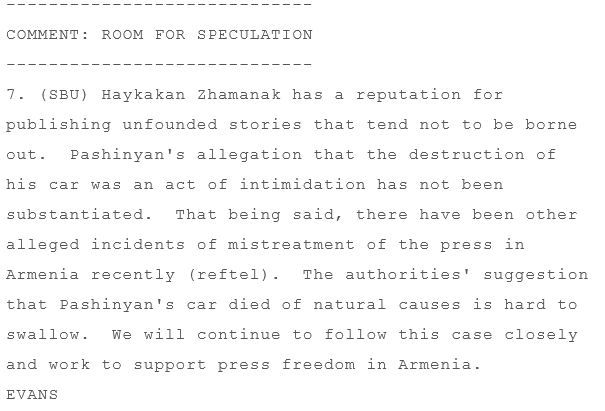
Curiously, the odium about Pashinyan was not enough to dissuade the National Endowment for Democracy from distributing a total of $81,265 to Haykakan Zhamanak between 2016 and 2017, the two years preceding Pashinyan’s usurpation of power. The NED only provides funding information for the past five years so it is impossible to know whether the paper received funding before 2016 unless it is reported elsewhere.
It is possible that Pashinyan did not receive as much money from foreign sources as other outlets because by the late 1990s he had already established himself as one of Levon Ter-Petrossian’s acolytes. As a result, he seems to have benefitted from the support of wealthy businessmen close to Ter-Petrossian like Alexander Sukiasyan. This is corroborated by a 2002 article in Radio Free Europe/Radio Liberty where Pashinyan says that, “20 percent of the newspaper’s costs are covered by ‘business circles,’ which he refuses to name.”
The Diasporan Hazard
The NGO funding system has also created the hazard of Diaspora Armenians without any discernible skills temporarily or permanently moving to the country to establish NGOs based on their inherently foreign paradigms that are much more congruous with those of the foreign funding organizations and governments than those of the local society.
It is no surprise that some of the largest beneficiaries of foreign funding are Diaspora Armenians who moved to Armenia and now receive large sums of money to conduct their activities. These include Lara Aharonian of the Women’s Resource Center, Richard Giragosian of the Regional Studies Center, Maro Matossian of the Women’s Support Center, Salpi Ghazarian of Civilitas/CivilNet, and Maria Titizian of EVN Report.
The Auxiliaries
Democracy Peddlers
To grasp the totality of the control over the narrative about Armenia’s politics, we cannot limit ourselves to the funding of players solely on the Armenia domestic scene. In fact, these have always been supported by a cadre of individuals, organizations, and governments outside Armenia.
One common phenomenon is the employment of individuals with Armenian names who work in think tanks and academia, often in the United States. These include people like Anna Ohanyan of Stonehill College, Nerses Kopalyan of the University of Nevada, Las Vegas (UNLV), and Vicken Cheterian, a researcher from Switzerland. Then there are entirely non-Armenian individuals whose chosen area of interest is Armenia and who seem to invariably adopt an approach that aligns perfectly with the foreign policy interests of the United States and the European Union in Armenia. These are individuals like Thomas de Waal, currently at the Carnegie Endowment, and Laurence Broers, affiliated with Chatham House and Conciliation Resources, the latter being the organization that produced the Armenian-Azerbaijani peace film in which CivilNet journalist Tatul Hakobyan participated. As might be expected, each of these individuals is a fixture on foreign-funded outlets like CivilNet and EVN Report.
Cheterian, for example, was invited, and accepted an invitation, to speak at the state-sponsored Azerbaijan Diplomatic Academy mere months after Azerbaijan was dropping cluster munitions on Armenian civilians in Artsakh. For her part, Ohanyan spills most of her ink on fear mongering about the threats to democracy in Armenia with titles “Is Democracy at Stake in Armenia?”, “Human Security Rests on Democracy,” “Security vs Democracy: A False Choice for Armenia.” This, like many a red herring, is primary concerned with distracting from the more important point: that the conversation must be about Armenia’s sovereignty, not the political system which it chooses, which may well be different than what academics in the US and think tank employees in New York City think it should be.
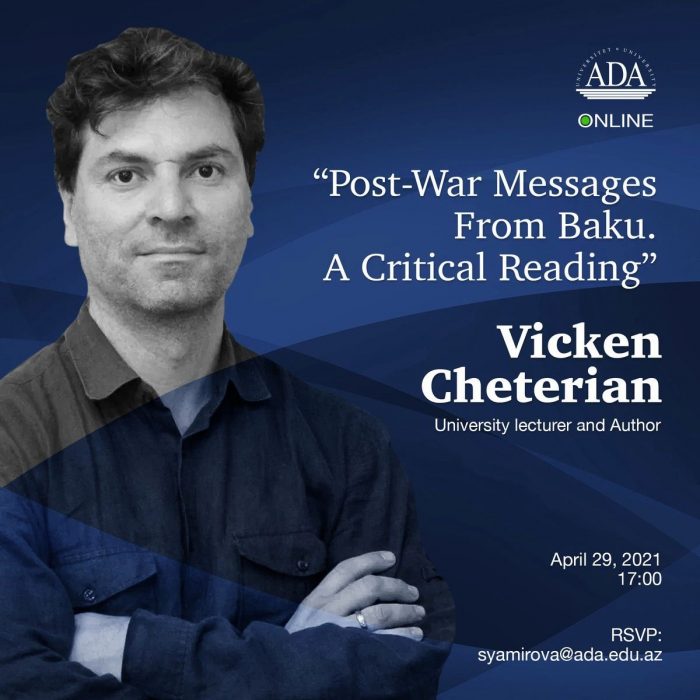
Kopalyan, on the other hand, an academic with astonishingly little information available about his academic background and who is an advisor to Pashinyan’s Diaspora Commissioner Zareh Sinanyan, writes regularly for EVN Report, which is funded by the National Endowment for Democracy and has received support from other foreign sources like the Germany-based Heinrich-Boll Foundation. EVN Report, like the others, has effectively acted as a wing of the pro-Pashinyan liberal democratic propaganda machine.
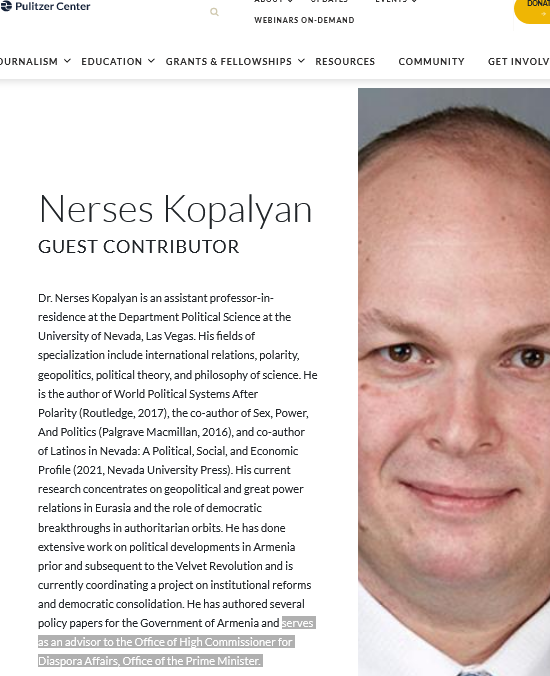
They also often appear in non-Armenian media outlets funded from the same international sources and which provide a similar service like Eurasianet (funded by Open Society Foundations and National Endowment for Democracy), OC Media (funded by OSF, NED, and the European Endowment for Democracy), JAM News (funded by the Open Information Partnership which is a project of the UK Foreign Office), and openDemocracy (funded by Open Society Foundations).
Glimmers of the collaboration between the various globalist forces working against Armenia’s national interests are visible in their occasional appearance together in the same forum. One example was the book Armenia’s Velvet Revolution: Authoritarian Decline and Civil Resistance in a Multipolar World (Bloomsbury, 2020) where the foreword was written by Salpi Ghazarian and a few chapters each by Anna Ohanyan and Laurence Broers. For his part, Broers was recently invited to – and participated in – an Azerbaijani whitewashing event with Ilham Aliyev.
A whole book about a major political event in a country and only two out of the twelve sections were written by local Armenians and one of those, Mikael Zolyan, is a member of the government who ascended to power. There is no interest, of course, in what the locals have to say: this is not a representation of local intellectual production but a presentation of the success of their efforts in influencing the minds and narrative of the Armenian Nation.
A Class of Its Own
The most popular news channel in Armenia, at least on YouTube, is Azatutyun, which is the sister outlet of Radio Free Europe/Radio Liberty (RFE/RL), which is fully funded by the United States Congress. The vast resources of Azatutyun are reflected in the comprehensive coverage it provides in print and video and delivered with a quality hard to match in Armenia where most outlets have a fraction of the resources.
As with any media outlet, it takes lengthy observation to understand its biases. With Azatutyun, much of its bias is in what it chooses to cover and what not to cover, what it says and what it does not say. For example, with one of two media outlets which first had the ability to report live (the other was foreign-funded CivilNet), Azatutyun made a point of being present at nearly every protest, however seemingly insignificant. During the 2018 protests that led to the resignation of Serzh Sargsyan and the usurpation to power of Nikol Pashinyan, Azatutyun offered round-the-clock coverage from as many vantage points as was possible. The omnipresent coverage of seemingly every last protest was very much in line with the policy of Azatutyun and other foreign-funded media leading up to 2018.
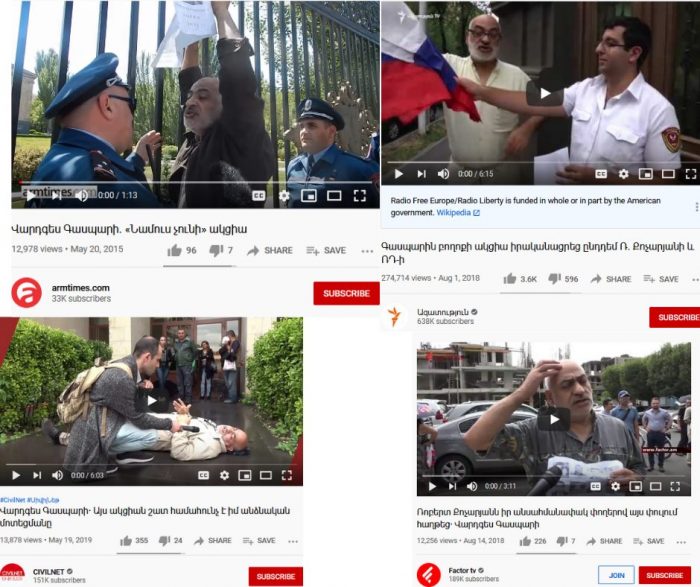
The effect of perpetual coverage is best grasped when viewed through the lens of mass psychology and the well-documented cognitive biases associated with it.
When the news continuously covers a social event that is open to public participation, it generates a number of psychological triggers. Among these are the fear of missing out on a potentially momentous event, social pressure to be a part of the crowd, and the bandwagon effect. That is, when people see that there is a group of people doing something – anything – they have a tendency to want to join them. As people join the original group, even more are encouraged to participate in what they can see is a growing number of people.
This phenomenon played out exactly according to the playbook in April of 2018 and the broad, round-the-clock, live coverage by Azatutyun and CivilNet exacerbated the internal political situation.
Arguing in Circles
The money in Armenia is not unidirectional. This means that it is not a one-way street where a funding government or organization provides money to a media outlet or NGO and that is the end of the story. What is especially deceptive about the foreign funding is that the reports produced by the media and NGO recipients of the foreign funding are then recycled and used in the meta-reports by these same governments and funding organizations to prove shortcomings in Armenian society.
The citations in many of the reports produced by the funding organizations and governments on questions of freedom, corruption, and other dubious measurement criteria that are themselves deemed by foreign governments and organizations as important are sourced from the very media outlets and NGOs they or their partner organizations fund. That is, they provide the funding for a certain objective, like “gender issues in Armenia,” which inevitably lead to an NGO or media outlet producing a report that determines that there is some gender-related issue in the country. The results of the report surprise no one because the grant proposal, while not explicitly seeking out a particular answer, often implies that the topic about which they are seeking a report is a problem.
The most pragmatic and forward-thinking NGOs also understand that their willingness and ability to provide the needed report behooves them because they can establish a reputation as a dependable local provider of “local perspectives.” The funding organization or government then uses these very reports or source that they paid for to conclude that there is a problem in the area that they had previously paid money to uncover. It is a win-win for the patron and the proxy because the patron affirms that there is a problem while the proxy enters the short list of “good” NGOs who provide the patron with the needed local cover to push their foreign agenda. This dynamic is reflected in the imbalance in funding between certain organizations in Armenia like the Union of Informed Citizens, Helsinki Citizens’ Assembly, Media Initiatives Center, and Transparency International Armenia receiving a disproportionately higher amount of funding than other organizations.
This dynamic is manifest in other ways, as well. For example, Freedom House, which makes unsolicited determinations about the level of freedom in Armenia and other countries, invites people like foreign-funded activist Hamazasp Danielyan, now a member of Pashinyan’s ruling faction in the Armenian National Assembly and who has received funding from Open Society Foundations and worked for the US government aid agency, USAID, to write its 2017 report describing Armenia as an authoritarian regime.
In this very report, Danielyan cites almost exclusively from globalist liberal and foreign-funded outfits including Carnegie Endowment, Human Rights Watch, Transparency International Armenia, Azatutyun, Open Society Foundations, Eurasianet, A1+, Helsinki Citizens’ Assembly. Out of 118 citations, no more than a handful were from independent, local Armenian media.
The recycling of content and people happens continuously. International NGOs like Transparency International, Amnesty International, Human Rights Watch, Reporters Without Borders, Freedom House, Carnegie Endowment, Chatham House, and several government ministries and international organizations, when preparing their reports to lambaste Armenia for its lackluster march toward a perfect liberal democracy, frequently call upon local foreign-funded outlets to provide them with the required narrative.
The rankings and assessments were then used to locally validate the very theses promoted by the foreign-funded organizations in Armenia that were the source for international report in the first place. This corrupt incestuous cycle between foreign patrons and their local proxies significantly contributed to the widespread malaise in Armenian society.
The Return on Investment
Starting with the most measurable results, Hovik Manucharyan has done yeoman’s work in compiling statistics related to the viewership of Armenian YouTube channels. He has discovered that the top news channel is Public TV but immediately behind them is Azatutyun, the channel of a foreign government. Not far behind the top two at #4 is Factor TV, heavily subsidized by the Open Society Foundations.
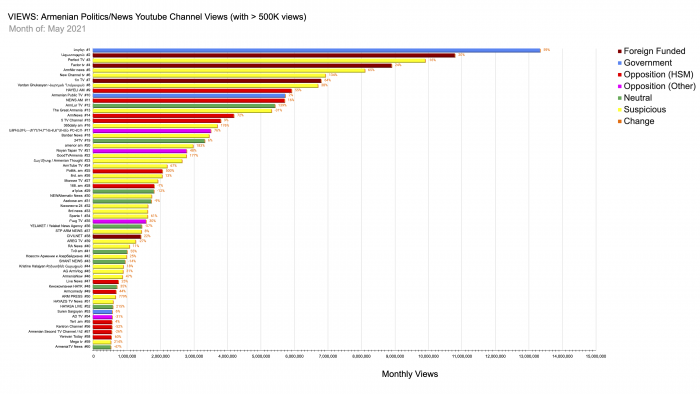
Currently, all three of these channels are considered pro-Pashinyan and, until April 2018, Azatutyun and Factor TV, were considered anti-government.
In May 2021 alone, Azatutyun racked up almost 11 million views, whereas Factor TV racked up almost 9 million. Along with 1in.am, another foreign-funded pro-government outlet, that brought in 7 million views and the public TV channel that had 13 million views, there were a combined 40 million views between these four pro-Pashinyan channels alone. By contrast, the top opposition channels had combined views of 16 million.
When foreign-funded outlets are given the resources to purchase the latest equipment and train and hire staff in ways that are unattainable for local media, the imbalance is reflected in viewership. This gives foreign-funded outlets undue influence in shaping the public opinion of Armenian society and, ultimately, the politial course of Armenia.
2018 Coup d’Etat (Or, If You Will, “Rebellion”; Or, If You Will, “Revolution”)
There is no clearer indication of the effect of the millions of dollars of foreign funding on Armenia than Nikol Pashinyan’s usurpation of power in 2018. It was the culmination of years of protests supported by foreign governments and organizations during which a solid cadre of professional activists had been created. This was concatenated with widespread societal angst and a general malaise that prevailed partly due to the decades-long bombardment of Armenian society through media outlets and local organizing reinforcing beliefs of supposed oppression. When you are constantly told that the presidents of your country have been stealing billions of dollars and making it impossible for anyone to do business, it inevitably has an impact, whether or not it is true.
This was most readily apparent in a widely-cited chart published by the European Bank for Reconstruction and Development (EBRD) in its 2016 Life in Transition Survey showing that Armenians had a seriously distorted view of corruption in their country. In this particular instance, while 35% of Armenian respondents said they believed they needed to pay bribes for public services, only about 10% reported actually having done so. The gap between perception and reality was widest in Armenia.
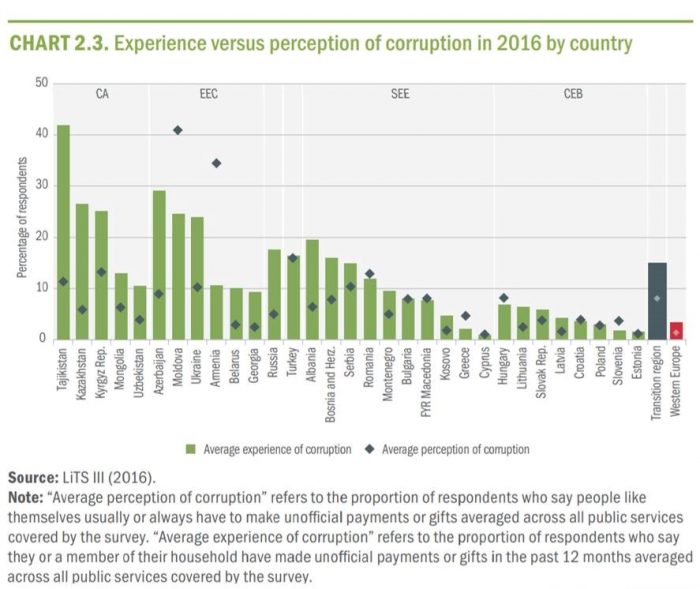
The results of the EBRD survey should not be understated. For years, Armenia suffered a significant slight to its reputation due to repetition of the trope that life in Armenia was insufferable because of overwhelming corruption. Dozens of reports were written on the subject and organizations like Transparency International Armenia owed their existence to this premise. Combined with lies told by people like Nikol Pashinyan about Robert Kocharyan’s supposed billions and allegations of Serzh Sargsyan’s brother’s business indiscretions, the climate was ripened for what came in April 2018. Pashinyan’s success in rallying protestors around this false rhetoric in 2018 is the proof that the work of the foreign-funded media outlets and NGOs was wildly successful.
Armenia, on the other hand, was not so lucky.
There was no reason to think Pashinyan could successfully govern a country at war and at the epicenter of the geopolitical games of regional and global superpowers. Unstable, dishonest, and with experience in nothing other than running two tabloid newspapers, Pashinyan spent the first several months of his tenure celebrating himself with food and drink. In one of their more self-aggrandizing gestures, his government created a Citizens Day holiday.
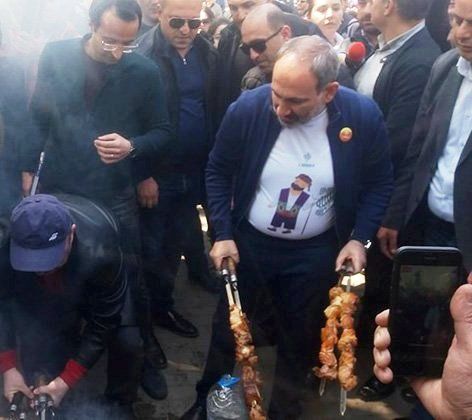
The Armenian Satrapy of the Liberal Democratic Empire
It was not just Pashinyan’s usurpation of power that was the indicator of the success of the millions of dollars in foreign funding – that was only the tip of the iceberg. Behind the team that worked on bringing Pashinyan to power were some of Armenia’s most notorious foreign-funded activists. One example was Armen Grigoryan, who went from working at Transparency International and being a columnist at CivilNet to becoming Armenia’s secretary of the national security council, the top civilian national security position in the country.
Another example is Arayik Harutyunyan, among Pashinyan’s closest confidantes and his education minister. Harutyunyan had likewise worked at Transparency International previously and, also, for a group called Army In Reality. Harutyunyan, who never served in the military, and this outfit spent years pushing a narrative in Armenian society that the army was a den of murder and suicide. Few organizations did as much damage to societal morale regarding the Armenian Army as it did.
Others include Ioannisyan, of the Union of Informed Citizens, who received a position on the electoral reform commission, and Sasun Khachatryan, the brother of the chairman of the board of Open Society Foundations in Armenia Davit Khachatryan, who was appointed as the head of the Special Investigations Committee.
Journalists from foreign-funded media were also well-represented. Sisak Gabrielyan of Azatutyun (Radio Free Europe/Radio Liberty) became a parliamentarian from Pashinyan’s party and Hovhannes Movsisyan, also of Azatutyun, became the executive director of the state-run public television channel, H1. In addition to Grigoryan, several other former CivilNet employees became part of Pashinyan’s administration, including Sargis Khandanyan, member of the National Assembly, and Mane Gevorgyan, Pashinyan’s spokeswoman.
The personnel changes brought with them the expectation that there would be changes in Armenia’s policies. Many of former defense minister Vigen Sargsyan’s military reforms were scrapped, there were attempts to reform the educational curriculum and remove references to nation-centric themes like removing a course on the Armenian Apostolic Church and, among others, to change the court system. Only some of these succeeded and, were it not for Pashinyan’s botched coronovavirus response and the war launched by Azerbaijan, it is likely that these would have eventually been realized.
In the end, flooding Armenia with millions of dollars by careless foreign actors in a permissive domestic climate that allowed the proliferation of thousands of NGOs led to the creation of false and dubious narratives upon which a libelous yellow journalist and his band of professional activists with no experience in little other than writing inflammatory articles, organizing protests, and applying to foreign grants led to a systematic dismantling of Armenia’s state institutions, the loss of a significant part of the remaining Armenian homeland and the inevitable erasure of cultural artifacts, and the death and displacement of thousands of Armenians.
The Exception to the Rule
In 1905, the Eulsa Treaty was signed, making Korea a protectorate of Japan and marking the end of the 600 years of the Kingdom of Joseon. This was neither the will of the emperor of Korea nor the people of Joseon. However, there were ministers within the imperial court that collaborated with the Japanese under the guise that Japan’s designs were beneficent in nature. These ministers, in the employ of the Japanese Empire, were those responsible for the signing of the treaty ending Korea’s sovereignty. Despite their lofty proclamations about their supposed good intentions, the people of Korea judged them for what they were and they have been forever memorialized as The Five Eulsa Traitors.
In the premodern era, there was little ambiguity about how to view an individual who took money or favors to promote the agenda of a foreign power in what they claimed was their country. In Armenia and many other countries today, that understanding has been muddled not by a diminishment of the practice but by its titanic growth.
For years, thousands of foreign-funded activists, media agents, and NGO employees in Armenia rivaled the number of people working in the Armenian government. A moment’s reflection should give any sober person pause: those that received funding from foreign governments and organizations from 1998 to 2018 to promote ideas, programs, and objectives that originated in faraway lands and with little connection to local Armenian custom, practice, tradition, philosophy, or need created a vibrant fifth column which aggresively undermined the interests of the domestic, elected government of Armenia. And, in 2018, those individuals who worked at the pleasure of foreign governments and organizations usurped power.
This scenario would be unconscionable in most mature countries but hardly elicits a batting of the proverbial eyelash in a developing country like Armenia that has been suckled on the intoxicating cocktail of the liberal democratic order’s most frequently used phrases. Anesthetized by the Western world’s flattery in the headlines of its instruction manuals masquerading as magazines and the rote glee or fury at the mention of those frequently used phrases – “democracy!” “corruption!” “oligarch!” – a hypnotized Armenia was guided back into the Platonic cave where reality was but a projection.
Wresting Back Armenia’s Sovereignty
In recent years, several countries, including Israel, Hungary, Russia, and China, have realized the deleterious effect that foreign-funded individuals and organizations can have on the proper development and functioning of their societies. As a consequence, they have formulated different ways of addressing the problem from requiring foreign agents and those funded by foreign sources to register the support they receive and disclose the information publicly to announcing that they are foreign-funded to outright bans. For this, they have been roundly condemned by the “democracy promotion network.”
This is ironic because they are only following in the footsteps of the United States, which has the oldest requirement to disclose foreign ownership or activity on behalf of a foreign power. The US established the Foreign Agents Registration Act in 1938 and continues to use it to this day. In fact, many foreign media outlets operating in the US including Al Jazeera, China Daily, Russia Today, and Japanese broadcaster NHK are registered as foreign agents – and this is in the largest and most powerful media market in the entire world.
Even with the presence of foreign media outlets, it is hard to fathom that the United States or, for that matter, China, Russia, France, or the UK allowing one of its top 3 broadcasters to be an outfit of a foreign government. But, this is exactly the case in Armenia with Azatutyun. And why is that? One can presume that the answer of any high-level official in those countries would have to do with with defending the national security of their country and preserving its sovereignty.
In fact, we do not need to speculate. Russia, which has been especially circumspect in overseeing the activities of foreign organizations operating on its territory or influencing local actors, has deemed the National Endowment for Democracy, Open Society Foundations, National Democratic Institute, and the Atlantic Council, as well as a number of other organizations, as “undesirable.” It described its banning of NED and OSF as being motivated by the fact that both pose “a threat to the foundations of the constitutional system of the Russian Federation and the security of the state.”
Moreover, the United States, until recently, had very restrictive regulations governing the foreign ownership of domestic media assets, particularly broadcast rights. The implication in this longtime ban on foreign ownership was that giving foreigners the ability to own media that could affect the opinions of the American public could be detrimental to interests of the United States.
While those restrictions have recently been relaxed, that has happened against the backdrop of the American media landscape shifting to Internet-based news coming from providers like Google (through search and its News platform), Apple News, Facebook, and Twitter, all of which are US-owned.
Duty
The famed founder and leader of Singapore, Lee Kwan Yew, said in response to liberal democrats trying to influence the course of his country, “It is my business to tell people not to foist their [political] system indiscriminately on societies in which it will not work.”
Armenia is in a unique and precarious geopolitical situation. It is not France, it is not the United States, it is not Norway, and it is not the United Kingdom. It is a small buffer state sandwiched between several powerful neighbors, one of which has repeatedly expressed its intent to obliterate it from the face of the earth. The pretext that NGOs and their foreign patrons are there to help Armenia become a modern, progressive, European-style state is not only false, it is disingenuous. It is disingenuous because it is impossible.
The experiences of other countries notwithstanding, Armenia has a right and a duty to its citizenry, as a sovereign country, to decide for itself what is in its best interests and choose the right course to eliminate the influence of foreign governments and organizations.
If Armenia is to preserve its sovereignty, its future government must adopt a policy that strictly limits the ability of non-Armenian actors and their local proxies to influence the future of the country. The limitations should include penalizing and banning those organizations that continue to disregard Armenia’s right to freely choose its own course. There should be no expectation that Armenia must subdue its own interests to those of powers that trying to defend their own national interests.
History has not ended and liberal democracy is not the only path forward. The survival and thriving of Armenia is dependent upon its ability to develop a national agenda premised upon its own interests and not those of any other, as is the right and duty of any sovereign country. It is time for Armenians to once again declare independence, this time from the grip of the foreign patrons and their local proxies who have dominated and decimated Armenia. With renewed independence, faith in self, and the resolve to forge a path unique to Armenia and the Armenian people, a new and dignified epoch for the Armenian Nation is nigh.
This report required hundreds of hours of work. The Armenite, unlike the organizations mentioned here, receives no funding from foreign governments, organizations, or international institutions. We depend on your support. Please consider contributing. Thank you.

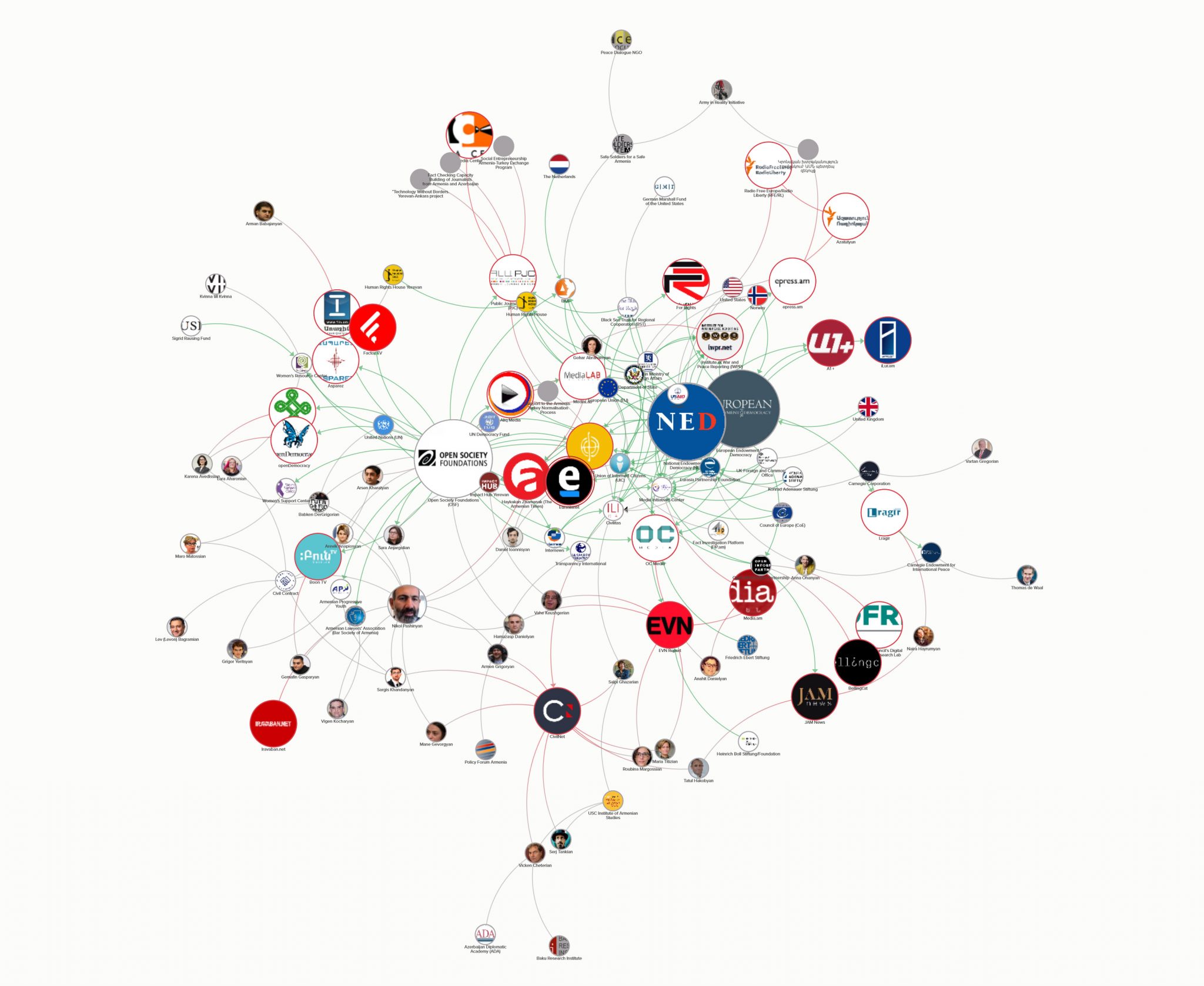
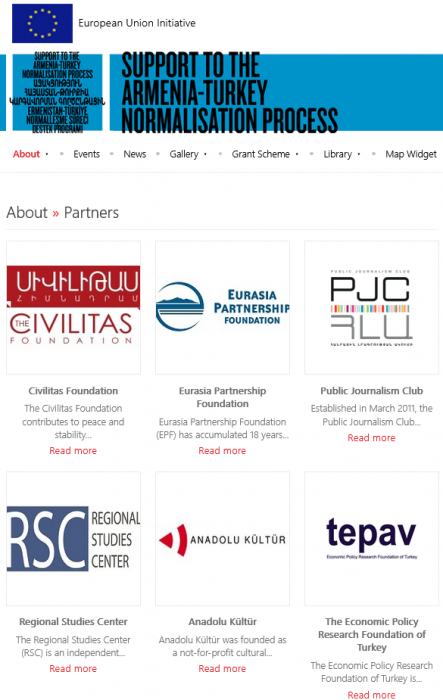
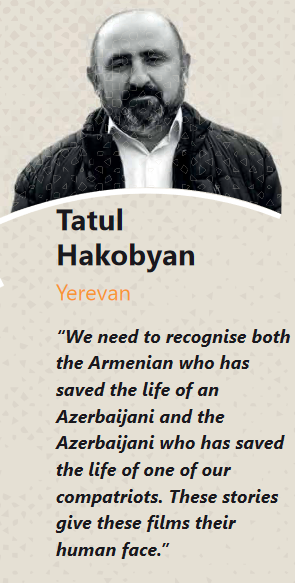
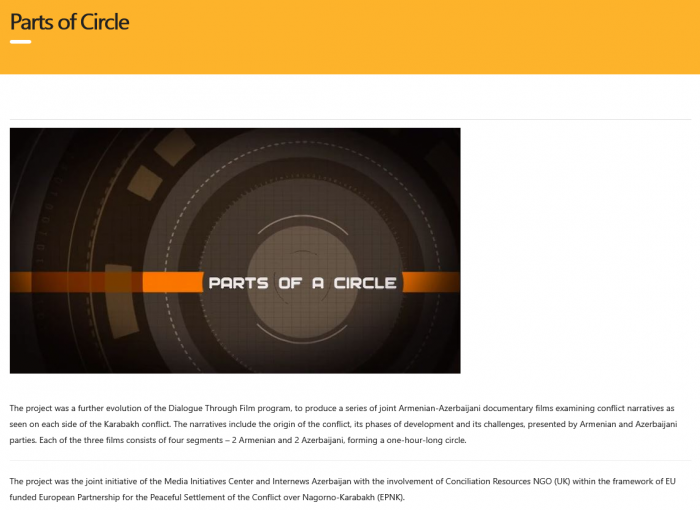
As always, great work.
Dear Mr. Bairamian,
A fantastic and well-researched piece, as always.
At the conclusion of the article, I launched the “Find in Page” function of my web browser and searched for the term “jew” to see whether I had truly missed or overlooked this critical factor behind domestic and foreign meddling in national affairs. Alas, the term was nowhere to be found.
Now, I do understand that some of the western-educated readers may scoff at this comment. I do not blame them one bit. When one is educated that the Earth is the center of the universe for their entire lives, it would be a bit difficult to break the habit. I do wish, however, to present my case using an alternative – albeit hypothetical – scenario.
Let us imagine that an enormously successful hedge fund manager, residing in Canada, has just recently reached the Forbes top 10 list of billionaires. This gentlemen carries the name of Aydin Caglar, and has spent a large amount of his personal wealth on “philanthropic” efforts. The funding has been primarily targeting the spread of democracy and so-called human rights initiatives by establishing educational institutions that would train the next generation of activists, free-of-charge. Following a major subversive event in Armenian society and government, it is discovered that the top brass of the Armenian administration have been educated at or are in some form, in association with one of those goodwill institutions in the country. Do we call this:
a) A Turkish Plot to Subvert the Armenian Nation and its values
b) A Canadian Plot to assert influence in the region, in lieu of better regional trade deals
c) A British Plot to continue its colonization activities through other means
Given that “Aydin Caglar” is clearly a Turkish name, and given that throughout his lifetime he was known to not have hidden his heritage, I’m certain we’ll all agree that the first choice, (a), would be the correct response.
Unfortunately, I consistently see great hesitance in calling a spade, a spade. It is, of course, understandable that in an effort to present oneself properly on the global stage, one should minimize negative labels and the damages they entail. Thus, one tends to avoid being on the receiving end of the label “anti-Semite”. But I always ponder this question: When it comes to our national struggle for survival, shall we not correctly identify the real wrongdoers, so as to arm ourselves with the correct intellectual thought process and understanding to aid us in identifying their next attempts at subversion?
The two major and well-known actors, the OSF and NED, are lead by one Mr. George Soros (György Schwartz) and one Mr. Carl Gershman, respectively. Even the most basic research into these individuals will unearth their real ethnic heritage (the first one is not Hungarian, and the second one is not American of Native European extraction), as well as their heavy involvement in Jewish programs and associations with Jewish individuals, throughout their lives and careers.
Of course, the reader is perhaps scoffing at this comment and searching for names of other individuals involved in other governmental positions or organizations, in an effort to reduce the subversive activities back to the approved terminologies: imperialist, capitalism, colonialism, etc.
While I’m happy to entertain a discussion of where Jewish influence or control of these programs begin, and where they end – I wanted to provide my frank view that if we are to prevail and counter subversion, we must first identify whether there are tribal programs at work. Lest we forget that one of Pashinyan’s major foreign policy actions was to establish an embassy in the State of Israel, thereby angering a friendly Iran, while it was the same Israeli nation which supplied arms to and aided the enemy in their massacre of Armenians during the 44 day war.
The State of Israel was, after all, labeled as the “national home of the Jewish people”, as part of the “Basic Law” enacted by the 20th Knesset in 2018.
This is a religious, ideological, and ethnic war on a global scale. We, Armenians, are among the many in their cross-hairs. Political correctness and false intellectualism will not be our salvation.
Tigran, you may be interested in these facts:
1. Upon the expulsion of the jews from Europe (Spain) in 1492, the Ottoman Sultan gave asylum to the sephardic jews and invited them to the Ottoman Empire where they were given basic freedoms, including freedom of worship. Since then, the jews consider the Ottoman Sultans to be their Savior, and thus about 500 years ago was born the turkish-jewish brotherly love. (See the recently published book, “Sultanic Saviors and Tolerant Turks: Writing Ottoman Jewish History, Denying the Armenian Genocide (Sephardi and Mizrahi Studies)”)
2. The Young Turk movement was actually a Zionist movement whose original goal was to give Palestine — then a part of the Ottoman Empire — to the jewish people. At the turn of the 19th century, a first attempt was made by a small group of Shabatean Jews (a.k.a. “donmeh” jews) by meeting with Sultan Abdul Hamid and offering him a bribe in gold worth about $30 billion in today’s money. The Sultan refused the bribe and responded angrily. Thus Plan B was put into place: a political revolution, with the help of minorities like Armenians (specifically, the early Armenian “revolutionaries”, particularly the ARF) to overthrow the Sultan. The revolution succeeded, and one of the men who let the Sultan know he is n0 longer Sultan was one Emmanuel Karasu, one of the three donmeh-sephardic jews from Salonica who had initially approached him with the bribe. Having duped the ARF with promises of equality, brotherhood with the turks and liberty, the ARF agreed to enlist all Armenian men of the Ottoman Empire into the ottoman army, not realizing that they would be executed. As such, instead of fighting for an independent Armenia, the able-bodied men Armenian population was led to their death by their “revolutionary” leadership, and the unprotected Armenian population was raped, slaughtered, or expelled from the Armenian homeland. (The details of this encounter and the real history of the Young Turks can be found in the book Օսմանեան յեղափոխութեան մութ ծալքերը, Beirut, 1938).
3. The Armenian Genocide has been methodically denied by jewish historians in American and other western universities, working closely with the Turkish government and the jewish community in Turkey. Even more, the jewish lobby has been the main obstacle for the recognition of the Armenian Genocide by the U.S. government. (Details in the first book above, “”Sultanic Saviors and Tolerant Turks: Writing Ottoman Jewish History, Denying the Armenian Genocide (Sephardi and Mizrahi Studies)”)
Regarding item #2, claiming the Young Turk movement was a Zionist movement is not accurate. Zionist Congresses were not pro-Turkish, nor anti-Armenian, but rather pro-Palestine colonization. See: https://moderndiplomacy.eu/2018/01/04/returns-diplomatic-investment-zionist-policies-armenians/
For sure, Crypto-Jew Donme and Zionists were involved in pre and post 1908 Young Turk revolution activity, including promulgating pan-Turkic ideology. Based on my research, this Zionists effort was to co-opt an Islamic association across the Ottoman Empire with multiple ethnic identities. This goal was directly related to British designs connected with Lawrence of Arabia and lesser-known agitators across the wider empire. In this way, there was a mechanism to dismember the Ottoman Empire. In the end, any European power having a mandate over Palestine would be in the Zionist interest.
One can accurately state that the proto-fascist Young Turk ideological movement resulted in the Turkification of Anatolia, with its most significant expression was the genocide of the Armenians.
However, because Constantinople was the seat of the Islamic Caliphate, even after 1908, pan-Turkism among the Islamic population of Turkey was not widespread. It took Mustafa Kemal to finish that process. The real hotbed of pan-Turkism was Baku.
Yerevan, Armenia
Hi David, I recommend you read Rifat Mevlanzade’s book I mentioned above (Օսմանեան յեղափոխութեան մութ ծալքերը)։ Have you come across it? It was written by a former Young Turk member of kurdish origin who published the work in ottoman turkish in the late 1920s in Aleppo. The book has only been translated into Western Armenian (and more recently I believe to Turkish). (I have a copy of the original ottoman turkish as well). The Armenian version of the book was first published in Beirut in 1938, then again in 1979, and a third publishing was made in Yerevan in 1991. In addition to details of the donmeh jews’ offer of a bribe to the Sultan which the Sultan refused and the details of the Young Turk revolution, the book also includes minutes from meetings of the Young Turk leadership that show that the most anti-Armenian elements among the young turk leadership who planned the genocide were indeed donmeh jews, namely Doctor Nazim, whose donmeh jew brother-in-law would later run the operation to destroy some of the evidence of the genocide (namely by pioneering the use of lime in order to decompose the Armenian dead in mass underground caves in the Syrian desert).
In any case, I highly recommend the aforementioned book which is a primary source and is important to translate into English to reach a broader audience (as I mentioned, I have a copy of the original ottoman turkish as well).
I have the book in Armenian. While it is a great reference, it does not provide a view the wider diplomatic angle, nor could it, given the reality of the time. May I suggest an interesting reference by Marc David Baer, “The Donme” pub. 2010. It provides details generally not published at the time of Mevlanzade.
The role of the Donme need not be underestimated nor exaggerated. Also, records of Zionist Congresses refer to the Ottoman Sultan as a murderer of Armenians with blood on his hands. Most delegates were split between any support for the Sultan, no matter what the stakes.
Regards
David, Yes, “The Dönme: Jewish Converts, Muslim Revolutionaries, and Secular Turks” is written by the same Marc David Baer who wrote the book I mentioned “Sultanic Saviors and Tolerant Turks: Writing Ottoman Jewish History, Denying the Armenian Genocide (Sephardi and Mizrahi Studies)”.
More than that book, I would recommend reading “The Burden of Silence: Sabbatai Sevi and the Evolution of the Ottoman-Turkish Dönmes” by Cengiz Sisman. It should be mentioned that a number of American jews with close ties (e.g. marriage, professorships in Turkey) today operate in Armenia, some under the guise of doing “academic research.” These jewish operatives in Armenia serve the interests of the 500-year-old turkish-jewish brotherhood, which we also saw in action during the 2020 war in Artsakh via pro-turkish coverage in jewish-controlled global media as well as via weapons and training to the Azeri military.
Dear Aram,
Those are indeed facts, long lost to the majority of our people: intellectual or otherwise.
While I was not aware of the book you referenced and just obtained a digital copy, I am well-read on the matter.
It is only the tip of the iceberg, as the Hamidian Massacres themselves were the end-result of a trial run for what eventually became known as the Zionist Action Committee. Next to the bribes, the Zionist movement sought to see whether the Ottoman Empire would ‘bend the knee’ and accept independence for a minority group, in this case the Armenians, as a test for a future independence movement in Palestine. By encouraging nationalistic fervor in the northeast of the empire, an uprising was fueled, which was then brutally crushed by the same Sultan Abdul-Hamid, resulting in the death of some 300,000 of our ancestors.
It is no secret that Theodor Herzl, the father of the modern Zionist movement, cooperated with the Sultan to restrict the flow of news of the massacres to the outside (and still Christian) world, by instructing fellow Jewish media magnates to avoid reporting on the plight of the Armenians. He is known to have said “Under no circumstances are the Armenians to learn that we want to use them in order to erect a Jewish state.”
It wasn’t until the ARF orchestrated the armed takeover of the European-run “Ottoman Bank” in Constantinople that European governments became aware of and admitted to the atrocities occurring within the empire.
Fast forward to the Genocide, and the same Young Turks had a propaganda and publication wing being funded by one Alexander Parvus (birth name: Israel Lazarevich Gelfand). A wealthy Jewish merchant from Belarus, who boasted a resume of genocidal activities: The attempted Russian Revolution of 1905, the involvement with the Young Turks, the Soviet Revolution, and activism in socialist circles in Germany.
As an addition to your first point, there was also another great migration of Eastern-European and Talmudic Jews to the Ottoman Empire in the mid-1600s, after Sabbatai Zevi of Smyrna had proclaimed himself to be the Jewish Messiah. A number of individuals who became known as “Donmehs” or crypto-Jews of the Ottoman Empire, were followers of this man.
I tend to not open with such facts, as it is a great historical revisionism to what our people are used to. When I see fellow Armenians marching for recognition of the 1915 Genocide, holding up banners of the alleged statement by Adolf Hitler, I wonder how many have truly researched the source of that quote. It famously goes “Who, after all, speaks today of the annihilation of the Armenians?” – of course, this is of great achievement for the Jewish elite, when a Jewish congressman (Adam Schiff) is standing on the same stage – constantly feeding the hope of official state recognition of Genocide (As a reminder, the US has not yet officially recognized the Armenian Genocide. A one-page commemorative statement by a US President is not law), while at the same time distributing a false narrative among Armenians.
During the Nuremberg trials, the victorious Allies attempted to eradicate the German high command and other high ranking members in their entirety. Grand Admiral Erich Raeder, having had a naval career his entire life, had no troubling past that could be used towards a death sentence. Thus, a Jewish staff member of the US Army, presented a forged transcript of an alleged “secret meeting” between Hitler and his generals, where such statements were supposedly made. Having been rushed to the court, the forgery became quickly apparent as it was debated by the legal teams. So much so that the document was put aside and not actually used towards prosecution of Raeder.
But that is where we are as a people. We yearn for the sympathy and acceptance of others – the wealthier they may be, the more pride our people displays in parroting their styles, values, and education. And who flaunts greater wealth in this world, than the Jew?
Amazing work once again, William. Please continue what you are doing. Although a bit to late in Armenia’s case, as the damage has already been done, you are nevertheless doing fundamentally essential work. All those reading this who are able to vote in Armenia’s upcoming historic elections, or know people who are, please understand that former president Robert Kocharyan is Armenia’s last hope. Please vote or encourage people to vote for Kocharyan as the nation’s future is at stake.
Robert Kocharyan is Armenia’s only hope – Summer, 2021
https://theriseofrussia.blogspot.com/2021/06/president-robert-kocharyan-is-armenias.html
I will not send The Armenite any money, because you would not accept money from an American advocacy of democracy. Shame, I could have given you lots. I am sure Donald Trump, Jair Bolsanaro, Alexander Lukashenko, Vladimir Putin, Bashar al-Assad, Abdel Fattah al-Sisi, Xi Jinping, Rodrigo Duterte, Mohammed bin Salman, Nicolas Maduro, Daniel Ortega, and Kim Jong Un would be more than happy to send you some cash from their Swiss bank accounts.
So you only send money to those who push your ideological agenda? How “democratic” of you. 🙂 Thanks for confirming the point.
Mr. Bairamian, this is welcomed work and congratulations on your effort. The conspicuous amassing of wealth in Armenia, previously plundered or foreign-financed was encouraged by the selective enforcement of laws.
What you eloquently describe is a symptom of not having a grand strategy as a reference point. Without this, little will change as all political debate is reduced to personalities rather than strategic policies, demonstrated yet again as election day approaches. Until Armenian national security is an active conversation topic, the damage will continue.
Yerevan, Armenia
A couple of notes.
Emmanuel Karasu was not a donme but a non-converted Jew, like the Turkish nationalist Munis Tekinalp (Moiz Cohen), another Salonican non-converted Jew. Both were later buried in Jewish cemeteries, something which donmes could not be allowed to.
Also, the donme were not the ones who offered money to Sultan Hamid II but the European Jewish Zionists. The donme could not afford to make any offers for Jews’ sake as they took pains to appear as good Muslims. Plus their financial means were nowhere close to European Jews’ finances to take up such an undertaking.
Lastly, it wasn’t ARF’s fault alone for the Armenian youth’s enlistments into the Ottoman Army. The Armenian wealthy elite and the Armenian church also went along with it — they just couldn’t say no while other Ottoman Christians were enlisting.
The ARF were openly allied with the Young Turks. This is a well-known, well-accepted fact. Instead of fighting for an independent Armenian, these so-called “revolutionaries” gave the entire able-bodied Armenian men that would have formed the Armenian military to the Ottoman Army without a fight. They were simply massacred.
It takes a leadership with a particularly low intelligence to allow its people to be massacred at the scale of 75% of the population being wiped out and 99% being exiled from their ancestral homeland.
Sad but true. We must face reality and not fool ourselves.
[…] The Story of Foreign Money in Armenia […]
[…] colorata” che nel 2019 ha portato al potere Nikol Pashinyan, ritenuto dal Cremlino, a ragione, troppo vicino alla […]
[…] https://thearmenite.com/2021/06/foreign-money-in-armenia-ngo-media-funding/ […]
[…] “nasce” da un movimento (seppur moderatamente) filo-occidentale, sostenuto dalla solita macchina politico-economico-mediatica delle rivoluzioni colorate nell’est Europa dagli anni Novanta ad oggi. La sua opposizione, […]
[…] [4] https://thearmenite.com/2021/06/foreign-money-in-armenia-ngo-media-funding/ […]
[…] americano tramite il National Endowment for Democracy (il cui ruolo è stato preminente anche nella rivoluzione colorata in Armenia e nell’Euromaidan) e sul cui sito si possono vedere oggi anche numerose collaborazioni con il […]